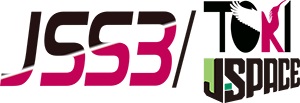Research for data assimilation of satellite global rainfall map
JAXA Supercomputer System Annual Report April 2017-March 2018
Report Number: R17ER0201
Subject Category: Space Technology
- Responsible Representative: Kinji Furukawa, GPM/DPR Project team
- Contact Information: Takuji Kubota kubota.takuji@jaxa.jp
- Members: Shunji Kotsuki, Koji Terasaki, Takemasa Miyoshi, Kaya Kanemaru, Masaki Satoh, Takuji Kubota
Abstract
This study explores an effective use of satellite data including GSMaP and GPM/DPR through an advanced ensemble data assimilation method for improving numerical weather prediction (NWP) and pioneering a new precipitation product based on an NWP model and satellite observations.
Reference URL
Please refer to ‘GPM Website‘.
Reasons for using JSS2
In this study, the JSS2 is used for the NICAM-LETKF experiments to assimilate satellite observations and to conduct NWP model forecasts. The JSS2 is a necessary infrastructure for our study to conduct massive computations for the ensemble-based data assimilation and ensemble atmospheric simulations.
Achievements of the Year
(1) Assimilating GPM/DPR reflectivity into NICAM-LETKF
This study pioneers to assimilate radar reflectivity measured by the Dual-frequency Precipitation Radar (DPR) onboard the Global Precipitation Measurement (GPM) core satellite into NICAM. We conduct the NICAM-LETKF experiments at 28-km horizontal resolution with explicit cloud microphysics of a single-moment 6-class bulk microphysics scheme. To simulate GPM/DPR reflectivity from NICAM model outputs, the joint-simulator (Hashino et al. 2013; JGR) is used. Our initial tests were promising, showing a better match with the observed reflectivity by assimilating GPM/DPR reflectivity (Fig. 1).
(2) Assimilating Microwave Humidity Sounder (MHS) into NICAM-LETKF
Microwave Humidity Sunder (MHS) observations in the clear sky condition are assimilated into the NICAM-LETKF. Without the MHS, the NICAM-LETKF assimilates very few humidity observations over the ocean. Assimilating the MHS generally improved temperature, wind and humidity fields (Fig. 2).
(3) The near-real-time system of the NICAM-LETKF
The near-real-time system of the NICAM-LETKF was installed on JSS2. The near-real-time NICAM-LETKF system has been stably running over 6 month, with a delay of 8 hours relative to the real time. The process includes pre-process and post-process (e.g. visualization) on JSS2 (Fig. 3).
(4) Ensemble forecast experiments with a high-resolution NICAM
Ensemble forecasts are performed with a high-resolution (14-km) NICAM from analyses of the NICAM-LETKF. Here, we focused on a heavy rain event occurred at July 2017 in Kyushu. Sensitivity experiments to the initial time revealed that the heavy rain would be predictable one-day before the heavy rain event by the NICAM (Fig.4).
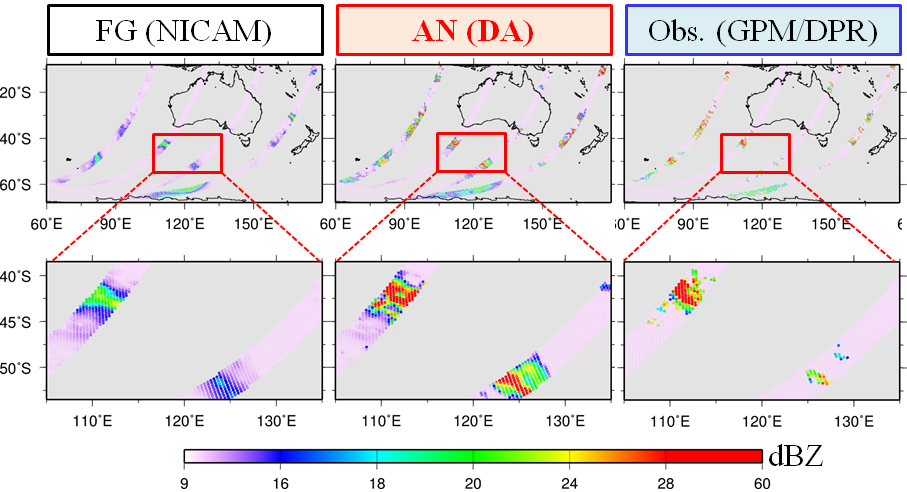
Fig.1: Spatial patterns of column maximum Ku-band radar reflectivity (dBZ) for (a) first guess, (b) analysis, and (c) observation at 0000UTC, June 17, 2014.
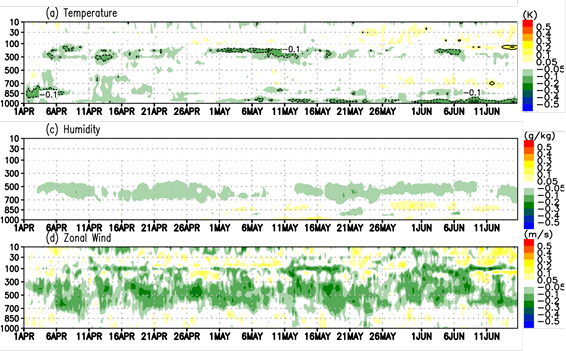
Fig.2: Time series of change in root mean square difference (RMSD) relative to the ERA-Interim reanalysis for (a) temperature (K), (b) mixing ratio (g kg-1), and (c) zonal wind (m s-1). The vertical and horizontal axes show the pressure level (hPa) and date-mont
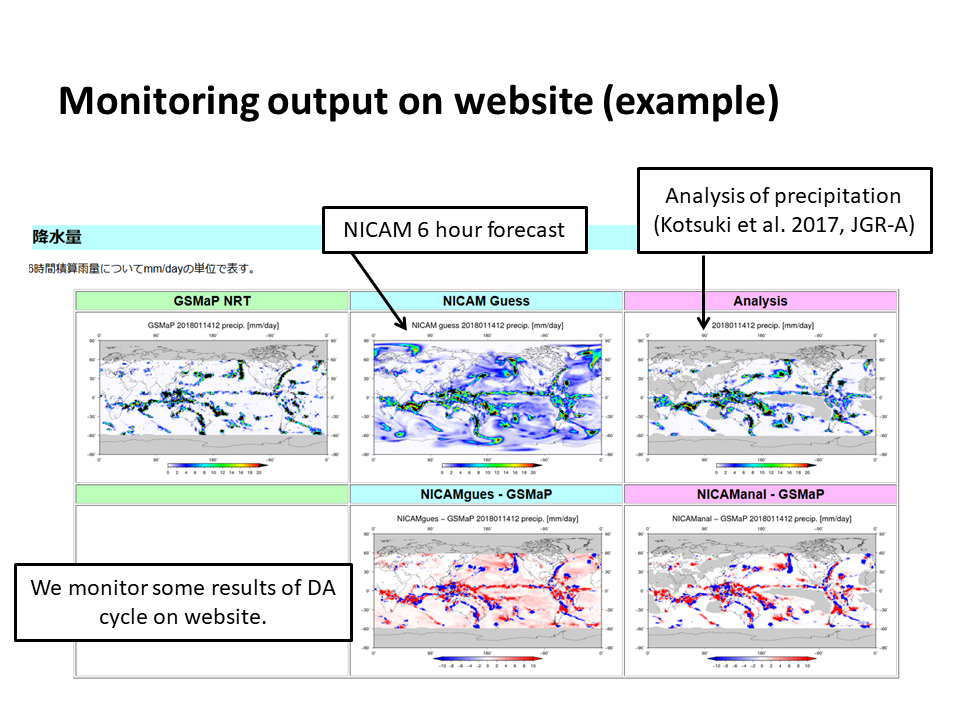
Fig.3: An example of automatically-generated monitor of the NICAM-LETKF output on at 12 UTC, January 14, 2018. Left, middle, and right panels show the 6-hour precipitation [mm d-1] for the GSMaP observation, first guess and analysis, respectively.
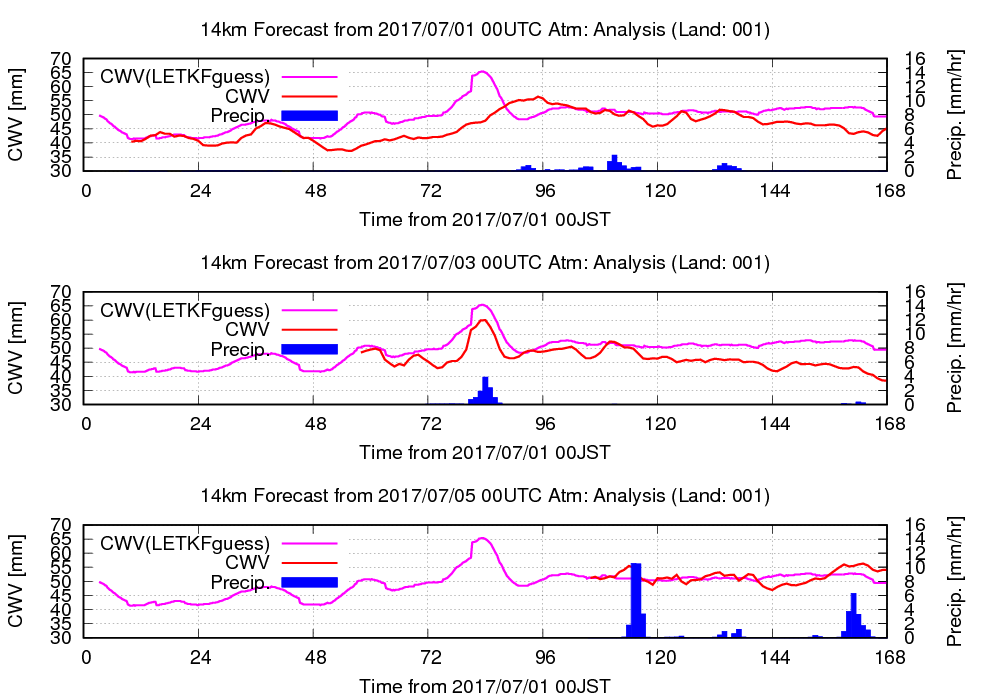
Fig.4: Time series of accumulated precipitation (blue boxes; mm h-1), and precipitable water (red and purple lunes; mm) at the Northern Kyushu region. Red lines represent forecasts by the 14-km NICAM initialized by (top) 00 UTC, July 3, (middle) 00 UTC, July 5,
Publications
■ Peer-reviewed papers
1) Kotsuki S., Ota Y., and Miyoshi T., 2017b: Adaptive covariance relaxation methods for ensemble data assimilation: Experiments in the real atmosphere. Quarterly Journal of the Royal Meteorological Society, 143, 2001-2015. doi: 10.1002/qj.3060.
2) Terasaki, K., and T. Miyoshi, 2017: Assimilating AMSU-A Radiances with the NICAM-LETKF. Journal of the Meteorological Society of Japan, 95, 433-446, doi:10.2151/jms.j2017-028.
■ Invited Presentations
1) 2017/04/07 T. Miyoshi, “Data Assimilation Research at RIKEN: Toward extreme-scale computation”, An examination of data assimilation algorithms, observations, and applications in the context of next-generation computing, National Science Foundation, Arlington, VA, USA.
2) 2017/05/22 K. Terasaki, T. Miyoshi, “Reconditioning the observation error covariance matrix in a local ensemble transform Kalman filter: experiments with Lorenz-96 model”, JpGU, Makuhari
3) 2017/07/24 T. Miyoshi, “Data Assimilation: Integrating model and measurements”, South-East Asian School on Tropical Atmospheric Science (SEASTAS), Singapore
4) 2017/08/08 Takemasa Miyoshi, Shunji Kotsuki, Koji Terasaki, Keiichi Kondo, Guo-Yuan Lien, Masaki Satoh,hirofumi Tomita, Eugenia Kalnay, “Enhancing Data Assimilation of GPM Observations”, Asia Oceania Geosciences Society (AOGS) 14th Annual Meeting, Singapore
5) 2017/09/11 Takemasa Miyoshi, “Data Assimilation Research at RIKEN: Numerical Weather Prediction and Beyond”, Atmosphere-ocean Joint Seminar, Univ. Tokyo.
■ Oral Presentations.
1) 2017/04/27 S. Kotsuki, K. Terasaki, H. Yashiro, H. Tomita, M. Satoh, and T. Miyoshi, “Model Parameter Estimation Using Ensemble Data Assimilation: A Case with the Nonhydrostatic Icosahedral Atmospheric Model NICAM and the Global Satellite Mapping of Precipitation Data”, The EGU General Assembly 2017, Vienna
2) 2017/05/21 S. Kotsuki, K. Terasaki, H. Yashiro, H. Tomita, M. Satoh, and T. Miyoshi, “Model Parameter Estimation Using Ensemble Data Assimilation: A Case with the Nonhydrostatic Icosahedral Atmospheric Model NICAM and the Global Satellite Mapping of Precipitation Data”, JPGU-AGU Joint Meeting 2017, Chiba
3) 2017/07/19 Kotsuki S. and Miyoshi T., “Leading Research on Data Assimilation in Numerical Weather Prediction”, AICS CAFE, 2017.
4) 2017/09/12 Kotsuki S., Terasaki K., and Miyoshi T., “Ensemble-Based Data Assimilation of GPM/DPR Reflectivity into the Nonhydrostatic Icosahedral Atmospheric Model NICAM”, 7th International WMO Symposium on Data Assimilation, Florianópolis, Brazil
5) 2018/03/05 Kotsuki S., Terasaki K., and Miyoshi T.: Ensemble-Based Data Assimilation of GPM/DPR Reflectivity into the Nonhydrostatic Icosahedral Atmospheric Model NICAM. 6th International Symposium on Data Assimilation, Ludwig-Maximilians-Universitat, Munich, Germany
6) 2017/10/26 金丸佳矢,佐藤正樹,寺崎康児,小槻峻司,三好健正,久保田拓志「JSS2を用いたNICAM-LETKFの準リアルタイム処理のシステム開発および利用」超高解像度大気モデル開発ワークショップ(NICAM開発者会議2017),淡路
■ Poster Presentations
1) 2017/05/20 K. Terasaki, S. Kotsukji, T. Miyoshi, “Two-year analysis experiments with NICAM-LETKF”, JpGU-AGU Joint Meeting 2017, Makuhari
2) 2017/09/11 Kotsuki S., Ota Y., and Miyoshi T., “Adaptive covariance relaxation methods for ensemble data assimilation based on innovation statistics”, 7th International WMO Symposium on Data Assimilation
3) 2018/02/07 Terasaki, K., and Miyoshi T., Accounting for the observation error correlation in data assimilation. AICS international symposium
4) 2018/02/08 Kotsuki S., Kurosawa K., and Miyoshi T.: Ensemble Forecast Sensitivity to Observations Verified with Multiple References. The 8th AICS International Symposium, RIKEN-AICS, Kobe, Japan
5) 2018/02/19 Kotsuki S., Kurosawa K., and Miyoshi T.: Ensemble Forecast Sensitivity to Observations Verified with Multiple References. RIKEN International Workshop on Uncertainty Quantification (UQWS), RIKEN-AICS, Kobe, Japan
6) 2018/03/05 Kotsuki S., Greybush S. J., and Miyoshi T.: On the assimilation order of the serial ensemble Kalman filter: A study with the Lorenz-96 model. 6th International Symposium on Data Assimilation, Ludwig-Maximilians-Universitat, Munich, Germany
7) 2018/03/05 Kotsuki S., Kurosawa K., and Miyoshi T.: Ensemble Forecast Sensitivity to Observations Verified with Multiple References. 6th International Symposium on Data Assimilation, Ludwig-Maximilians-Universitat, Munich, Germany
8) 2017/10/17 Kaya Kanemaru, Masaki Satoh, Koji Terasaki, Shunji Totsuki, Takemasa Miyoshi, and Takuji Kubota : A Near-Real-Time System of NICAM-LETKF Assmilating GSMaP, 2017 PMM Science Team Meeting, San Diego
■ URLs for the Research Results on the Web
1) http://www.data-assimilation.riken.jp/nicam-letkf/index.html
2) http://cesdweb.aori.u-tokyo.ac.jp/~nicam/index-e.html
Usage of JSS2
Computational Information
- Process Parallelization Methods: MPI
- Thread Parallelization Methods: OpenMP
- Number of Processes: 2 – 640
- Elapsed Time per Case: 10.00 hours
Resources Used
Fraction of Usage in Total Resources*1(%): 6.38
Details
Please refer to System Configuration of JSS2 for the system configuration and major specifications of JSS2.
| System Name | Amount of Core Time(core x hours) | Fraction of Usage*2(%) |
|---|---|---|
| SORA-MA | 50,782,484.98 | 6.70 |
| SORA-PP | 28,731.17 | 0.36 |
| SORA-LM | 66.93 | 0.03 |
| SORA-TPP | 0.00 | 0.00 |
| File System Name | Storage Assigned(GiB) | Fraction of Usage*2(%) |
|---|---|---|
| /home | 1,449.59 | 1.00 |
| /data | 557,022.35 | 10.30 |
| /ltmp | 9,765.63 | 0.74 |
| Archiver Name | Storage Used(TiB) | Fraction of Usage*2(%) |
|---|---|---|
| J-SPACE | 18.41 | 0.79 |
*1: Fraction of Usage in Total Resources: Weighted average of three resource types (Computing, File System, and Archiver).
*2: Fraction of Usage:Percentage of usage relative to each resource used in one year.
JAXA Supercomputer System Annual Report April 2017-March 2018

